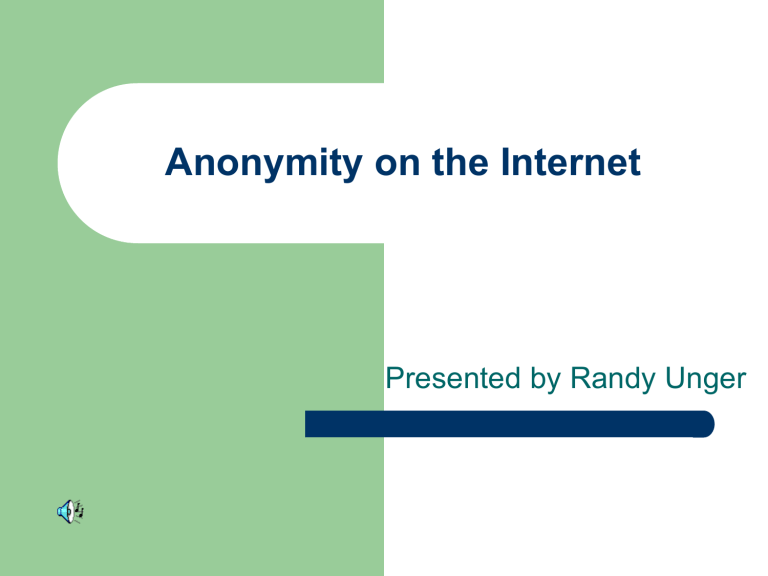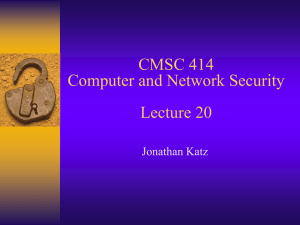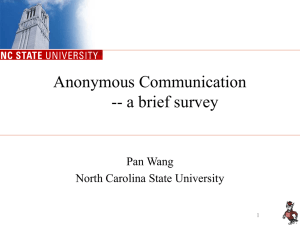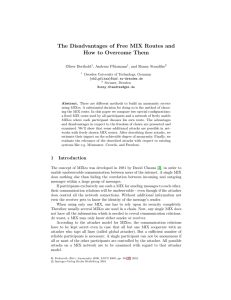Anonymity on the Internet Presented by Randy Unger

Anonymity on the Internet
Presented by Randy Unger
Types of Anonymity
Pseudonymity
– Susceptible to subpoenas
Sender
–
Receiver / observer can’t identify sender
Receiver
–
Observer can’t identify receiver
Sender-receiver
–
Observer can’t identify that communication has been sent
Uses of Anonymity
Positive
Free speech for political claims as well as non-political comments
engage in whistle-blowing conduct commercial transactions freedom from detection, retribution, and embarrassment
New York Times Co. vs. Sullivan, 1964
"an author's decision to remain anonymous...is an aspect of the freedom of speech protected by the First
Amendment"
Uses of Anonymity
Negative
Spam
DoS -
Illegal activity – anonymous bribery, copyright infringement, harassment, financial scams, disclosure of trade secrets
Assumptions
Weak attacker
– Eavesdrops on first and last hop
– Can introduce messages here
Strong attacker
–
–
Eavesdrops on all links
Can introduce messages anywhere
Attacker has finite time, computing power
Multiple users
Types of Attackers
Local eavesdropper
– Observes inbound and outbound messages on user’s computer
Administrator
– Operator or group of operators of anonymizing systems attempting to foil their own system
Remote attack
– Observation at the remote end by eavesdropper or attack by the remote host
Attacks
Timing Attack, Volume Attack
– Watches shape of traffic instead of content
Flooding Attack
– With batch size n, attacker sends n-1 messages
Usage Pattern Attack
– Consistent usage patterns leads to predictability
Levels of Anonymity
Absolute
Privacy
Beyond
Suspicion
Probable
Innocence
Possible
Innocence
Exposed Provably
Exposed
•Beyond Suspicion
•Attacker can see evidence of a sent message, but the sender appears no more likely to be the originator than any other potential sender in the system
•Probable Innocence
•The sender is more likely the originator than any other potential sender, but there is equal likelihood the sender is not the originator
•Possible Innocence
•The sender appears more likely to be the originator than to not be the originator, but there’s still a non-trivial probability that the originator is someone else
Capabilities
Latency, Bandwidth, Anonymity
– Pick 2
Human element
– Repetitive usage patterns make attacks easier
– Pizza effect
Proxy Anonymizers
Use trusted centralized servers
Anonymous remailers - Helsingius
Anonymizer.com
Hides IP address - NAT
Users not anonymous to proxy server
Susceptible to traffic analysis
Mixes
Source routing chosen by user
Shuffles order of packets
Mix cascade consists of several mixes under separate operators
Encrypted for each mix in the path
Processes packets in batches
Used to counter traffic analysis
Ai = Next Hop Address
Ci = Message encrypted with public key of Mix i
S = Destination Host address
M = Original message
Mixes
1.
Mix 1 Mix 2
3.
2.
Mix 4
Mix 3
4.
1.
2.
A1, C1(A3, C3(A2, C2(S, M, r2), r3), r1)
A3, C3(A2, C2(S, M, r2), r3)
3.
4.
A2, C2(S, M, r2)
S, M
Mixes
Fine for non real-time (email)
Not sufficient for VoIP, video, web
Mix waits to accumulate inputs to process as a batch (especially slow for low traffic)
Enhancements
Messages all the same length
Buffers messages until several can be sent at once
Dummy messages inserted
–
–
Between mixes
Between mixes and user
Balance end to end throughput with anonymity
– Duration to wait for mixes to accumulate traffic
– Percentage of dummy traffic
P
5
Decentralized
– Harder to attack
Allows choice of tradeoff between anonymity / throughput
Encrypted with public key of each node in route
Nodes change packet order
Fixed message size
Users have broadcast map and route map
Noise packets counter statistical traffic analysis
User A
User B
Hash of User’s public key provides choice of groups.
User A can send an anonymous message to User B via group */0, 1/1, 111/3, etc
01/2 is a subset of */0 – more efficient but less anonymous
User A can route messages between 00/2 and 01/2
Broadcast hierarchy independent of network topology
P
5
Within a channel, P 5 functions as a mix cascade
Between channels, P 5 provides greater anonymity per bandwidth
– For 8192 users, 1.5 Mbps provides 200Kbps with 40% loss
Resistant to Timing/Volume and DoS attacks
Susceptible to Flood Attack (Mob Attack)
–
User’s channel is flooded, prompting him to reveal more of his mask to gain efficiency, thereby reducing his anonymity
Conclusion
Costly to be anonymous
– Tradeoff with throughput
Can not be completely anonymous anyway
– No protection from monitoring usage patterns
Aside from this, practical anonymity can be achieved





